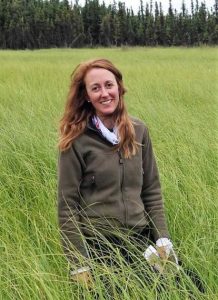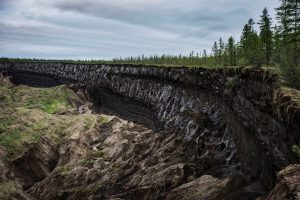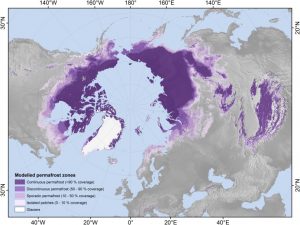A faster permafrost thaw means even the worst scenarios underestimated the pace and severity of climate change. Canadian scientist Merritt Turetsky explains “abrupt permafrost thaw”. Then from Princeton, atmospheric scientist Jane Baldwin: back-to-back heat waves are in your future.
Listen to or download this Radio Ecoshock show in CD Quality (57 MB) or Lo-Fi (14 MB)
Or you can select one of the interviews in this show.
Listen to or download my 31 minute interview with Merritt Turetsky in CD Quality or Lo-Fi
Listen to or download my 27 minute interview with Jane Baldwin in CD Quality or Lo-Fi
In our second interview, you hear how we will experience repeating heat waves more often as the world warms. That can affect global agriculture. We already have crop failure or smaller planting in many parts of the world. Due to drought, major producer Australia is importing wheat for the first time in 12 years. Floods have left over a million acres of crops partly or wholly destroyed in Argentina, another major international grain source. You may have heard about the crop failure in North Korea, bringing back extreme hunger there.
Some Canadian farmers have been unable to plant due to floods, or lost winter crops due to extreme and unstable weather this year. I’ve already covered major flooding damage to grain storage and fields in the Mid-western United States. Combined with the Tariff war, where China has cancelled soy bean purchases, while India stopped importing American Lentils, and countless U.S. farmers are not planting, and probably not staying in business.
Long periods of extreme heat are predicted for the Mediterranean this summer, at times moving even into northern Europe. There is some better news in Europe, where Greens won more seats in the European Union Parliament voting. Greens came in second in Germany, third in France and did better in the rest of Northern Europe. European voters are worried and want real climate action.
ABRUPT PERMAFROST THAW WITH MERRITT TURETSKY
Scientists have issued a new warning that greenhouse gas emissions from thawing permafrost in the North could be twice what we thought, as the world warms. Scientist Merritt Turetsky is lead author of the article in the journal Nature “Permafrost collapse is accelerating carbon release“, published April 30, 2019.
Merritt is Associate Professor & Canada Research Chair, Tier 2 at Canada’s Guelph University and head of the Turetsky Lab. Studying Arctic carbon cycles, northern fires, soils, and peatlands, she is author or co-author of almost 200 peer-reviewed papers. Merritt’s Twitter handle is: “Queenofpeat“.

Dr. Merritt Turetsky, Guelph University Canada
Scientists on Merritt’s team warn that greenhouse gas emissions from thawing permafrost could be twice what current models expect. Formerly all estimates on the amount of carbon dioxide and methane coming out of thawing vegetative matter in the far north were based on a slow general warming. However, there are large areas which contain a lot of frozen water with that soil. These regions can thaw abruptly – and may result in the formation of millions of small ponds and lakes. When vegetation rots below water, the more powerful greenhouse gas methane rises up into the atmosphere. About one-quarter of the land in the Northern Hemisphere is frozen – that is a vast area that we ignore at our peril!
As Merritt’s team write in Nature:
“Current models of greenhouse-gas release and climate assume that permafrost thaws gradually from the surface downwards. Deeper layers of organic matter are exposed over decades or even centuries, and some models are beginning to track these slow changes.
But models are ignoring an even more troubling problem. Frozen soil doesn’t just lock up carbon — it physically holds the landscape together. Across the Arctic and Boreal regions, permafrost is collapsing suddenly as pockets of ice within it melt. Instead of a few centimeters of soil thawing each year, several meters of soil can become destabilized within days or weeks. The land can sink and be inundated by swelling lakes and wetlands.”
A graphic with that paper says:
“One-fifth of frozen soils at high latitudes are thawing rapidly and becoming unstable, leading to landslides and floods that release carbon into the atmosphere.”
Previous estimates, including those used by the Intergovernmental Panel on Climate Change to advise governments, did not include this abrupt thaw and formation of gases. Keep in mind, in total there is twice as much carbon locked up in the Arctic than in the atmosphere now. If it was all released, or even a significant fraction, this would dwarf human emissions. There would be nothing we could do to stop it.
However, the IPCC’s “Special Report on the Ocean and Cryosphere in a Changing Climate“, expected later this year, should contain updated estimates including abrupt permafrost thaw, thanks in part to the Permafrost Carbon Network.
Nothing resembling a total thaw is going to happen in the next few hundred years. It takes time, but permafrost lands containing a lot of frozen water (ice) can melt within a decade (not all of it, but in places). One of those land-types is called “Yedoma“. This is widespread in Russian Siberia, but also in northern Canada and Alaska.

Permafrost crater in Russia. Photo credit Yuri-Kozyrev-NOOR-eyevine
In 2012, I recorded Merritt’s co-author Charles Koven’s presentation to the American Academy for the Advancement of Science conference in Vancouver. I then interviewed Professor Antoni Lewkowitcz. You can listen to both of those in my program “What If The Permafrost Thaws?”.
My first impression was the study of permafrost in 2012 involved a relatively small group of scientists in North America. That was during the time of Canadian Prime Minister Stephen Harper, who defunded climate change research. Merritt tells us the Arctic research situation improved in Canada, and in Russia – in fact over 20 countries have representatives in the Permafrost Carbon Network. It’s become a “hot” topic, now that the world is more aware of the grave dangers coming from global warming.
Now we now that greenhouse gases from thawing permafrost become a serious positive feedback loop – where warming creates more gases that lead to more warming. What is needed now, these scientists suggest, is an urgent project to understand and measure greenhouse gases coming from the permafrost.
In permafrost news, Dr. Jaroslav Obu and colleagues from several countries have just released a new map of permafrost. This new tool can help a lot of researchers. Also upcoming: the will be held in September in Washington D.C.

Permafrost model zones from Obu paper.
=================================================================================
BACK-TO-BACK HEAT WAVES WITH JANE BALDWIN
Are you ready for back-to-back scorching heat waves? Probably not. New research from scientists at Princeton say heat waves are coming strong and closer together as the planet warms. Wherever you live, you are going to feel this.
Our guest is the lead author of the new paper “Temporally Compound Heat Wave Events and Global Warming: An Emerging Hazard“. Jane Wilson Baldwin is a postdoctoral research associate with the Princeton Environmental Institute in New Jersey.

Dr. Jane Balwin, Princeton
Northern Europe experienced them in 2018, and multiple close-in-time heat waves hit the Mediterranean the year before that. This phenomenon does not require absolute record heat. It’s just that you might experience several days of very hot weather, perhaps a break for a day or two, and then bam! – another heat wave strikes again. Before the year 2000, that seldom happened.
This new heat pattern is called “compound heat wave events” by scientists. It is very important on several levels. Of course we humans recognize that when people do not get time to get over the first wave, the second may bring more heat deaths.
As we discuss in our interview, that is partly because our buildings do not get a change to cool of either. Homes, businesses and large buildings may hold the first heat right into the second heat wave. So things don’t get a chance to cool down. The environmental group WE ACT in Harlem, New York says inner city residents are more vulnerable to recurring heat waves. They did a study measuring heat in various Harlem buildings, and guess what: the poorest people lived in places that held heat the longest.
As a side note: in October 2019 the pseudo-environmentalists Ted Nordhaus and Micheal Shellenberger announced the death of environmentalism – and trashed the group WE ACT specifically. I interviewed the surprised and shocked Executive Director of WE ACT – who said they were far from “dead”! You can listen to that show here at archive.org.
BACK TO REAL SCIENCE – HEATING CITIES, FARMS, AND FORESTS
Plus, we have to add in the urban heat island effect pushing up the temperature in inner cities. Jane Baldwin has also been a co-author on several papers looking at the Urban Heat Island effect, like this 2017 paper: Zhao, Lei, et al. “Interactions between urban heat islands and heat waves”. Environmental Research Letters.
Similarly, plant growth can be affected when they cannot get recovery time either. That means yet another climate stress to agriculture and food production – like the food you buy. In my research for this interview, I also found science showing that fir trees in the forest can be stunned by high heat with residual effects lasting up to 6 weeks. Again, if the heat returns quickly, the trees don’t get a chance to recover. I presume we should expect more forest die-off, and the forest fires, when we get back-to-back heat waves.
Part of this is simple science sense. If we heat up the world, and we experience high heat periods more often in the summer, then there are going to be more times when it is extra hot. So some heat waves will be contiguous. But it’s not that simple. For example, I asked Jane Baldwin if the phenomenon of weather stalling, due to slow moving bends in the Jet Stream, would also lead to more “compound” heat waves. So far, she says the data does not depend on that Jet Stream change.
IT’S NOT JUST THE BODY COUNT
Of course it’s important and sad when people die prematurely from heat. Millions do, especially seniors and people with other medical conditions. A Radio Ecoshock guest told us that heat now kills more people in Australia than car accidents. But we also have to be careful when measuring heat waves only by mortality.
For example, India used to have many more heat deaths than currently. The government realized the problem, and there are relatively low-cost solutions. For one thing, we can warn people to stay inside and avoid strenuous exercise (not so possible for outdoor workers). We can offer cooling centers in major cities. In the early stages of global warming, humans can adapt relatively easily, so the body count during heat waves may not be as serious as the heat itself. But we can only adapt so far, and that’s true especially in developing countries (where there may not even be electricity for air conditioning).
By the way, northern India just experienced an excruciating heat wave with temperatures above 50 degrees C (122 F). There were at least dozens of deaths. I’ll be talking to Paul Beckwith about that (among other things) next week.
The other problem is that heat deaths are still wildly underestimated, and not even counted in some countries. Physicians write down the cause of death as heart problems or other illness. Some do not even have a category for “heat” as a cause of death. So statistics are hard to come by.
VINDICATING OPPENHEIMER
One co-author of this new paper on compound heat waves is the esteemed scientist Michael Oppenheimer. Way back in 1990, Michael wrote the book “Dead Heat, The Race Against the Greenhouse Effect”. Dr. Oppenheimer became a punching bag for the far-right for a long time. Now those climate denial voices have changed from “what heat?” to “It’s hotter but nothing we can’t handle”. I think real heat, felt by everyone now, has vindicated Dr. Oppenheimer.
Along with another co-author Gabriel Vecchi, Jane also specializes in the study of climate and Asian cyclones. We’ve had some terrible tropical cyclones in the past few years. We briefly discuss that science.
MORE RESOURCES FOR YOU ON COMING MULTI-HEAT WAVES
To get more on this new paper by Baldwin et al on compound heat waves, check out this Princeton press release.
“One heat wave after another will leave emergency service providers and infrastructure-repair crews with less time to recover from the past event before being confronted by new heat waves, Baldwin said. Additionally, those housed in buildings lacking climate control systems will be subjected to even greater periods of heat, as structures tend to retain heat. Citing a recent study, Baldwin noted that “surveys of low-income housing in places such as Harlem have found that after a heat wave has ended, temperatures indoors can remain elevated for a number of days.”
Or this popular press article about back-to-back heat waves in Grist.
Grist author Justine Calma notes that heat is most deadly for immigrants, especially Hispanics:
“Some communities bear more of the risks associated with extreme heat than others. A 2017 study published in the American Journal of Public Health found that immigrants are three times more likely to die from heat-related illnesses compared to citizens. More than 85 percent of non-U.S. citizens who died from heat-related causes were Hispanic. Researchers hypothesized that working outdoors and in agriculture increased vulnerability, particularly for younger immigrants. They also pointed to prolonged heat exposure during border crossings, which are becoming increasingly perilous as migrants risk more remote routes to the U.S. amidst heightened border security and the Trump administration’s efforts to make it more difficult to qualify for asylum. Three states that border Mexico — California, Arizona, and Texas — accounted for nearly 95 percent of all heat-related deaths of non-U.S. citizens.”
MORE ON HEAT IMPACTS ON ANIMALS AND PLANTS
There is this related new paper “Heat Waves, the New Normal: Summertime Temperature Extremes Will Impact Animals, Ecosystems, and Human Communities” by Jonathon Stillman of San Francisco, published in February 2019.
Stillman wrote:
“Summertime is quickly becoming a deadly season for life on Earth.”
See also this article about the Stillman review that lists some impacts on various types of life: “Too hot for comfort: the physiological dangers of extreme heat” published by the American Physiological Society,
That is another packed show for this week. Next week I’ll be talking with the experienced meteorologist Richard Rood, and then we’ll follow up with more weather/climate analysis with our regular contributor Canadian scientist Paul Beckwith. It won’t be pretty but it will be true.
Please continue to support my efforts to get this climate news out there. I need your financial support to keep going, in any amount. You can find various options to help here.
I totally appreciate having you as a blog reader and listener. Please tell others about this program, in any way you can.
Alex
Please note that the links (both high- and low-bitrate) to download the individual interviews are broken (i.e., they 404) as of 1930 UTC 7 Jun 2019, and they haven’t worked since the 1st time I tried (5 Jun 2019). Both links to download the whole show work, but I prefer to download the interviews individually (since I save ones I find useful). Please fix.
Note that I’m fairly sure the problem is not on my end: I’ve successfully downloaded a lotta audio today, and I download Ecoshock interviews fairly frequently.
Thanks Tom I’ll look into those links and fix them. Alex
The interview download links (at least, the lo-fi ones) are working as of 1630 UTC 9 Jun 2019. Thanks for fixing.
Perhaps Prof Turetsky’s calculations on abrupt permafrost thawing need updating for 2022 in light of the apparently innumerable subterranean fires that are now burning in Siberian permafrost peatland year round. The thawing effects below ground from such fires is presumably compounded by combustion of released methane gas pockets, as well as above ground ever-drier tundra & more extensive forest fires.